Exploring Leadership & Management Theories at Hays: An Analysis
VerifiedAdded on 2023/06/15
|9
|2613
|432
Report
AI Summary
This report provides a detailed analysis of leadership and management theories within Hays, a leading specialist recruitment group. It examines various leadership theories, such as behavioral and managerial leadership, and their relation to Hays' management activities. The report also explores management theories like scientific and human relations, assessing different leadership and management styles, including transformational and autocratic, and their application in various business situations within Hays. Furthermore, it identifies factors influencing the development of culture within the organization, such as business size, founder influence, and market dynamics, concluding with insights on how these elements contribute to the company's success. Desklib provides access to this assignment and many other resources for students.
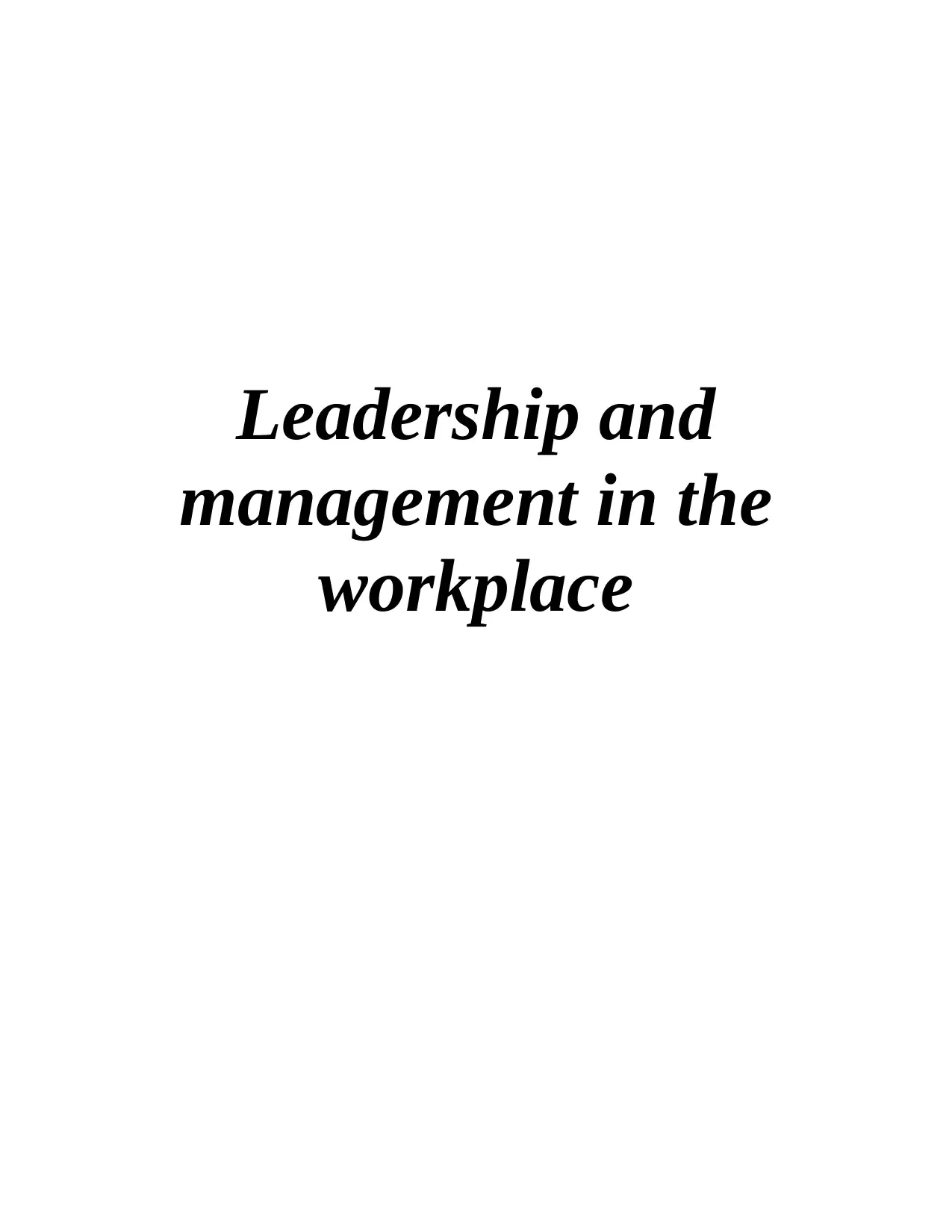
Leadership and
management in the
workplace
management in the
workplace
Paraphrase This Document
Need a fresh take? Get an instant paraphrase of this document with our AI Paraphraser
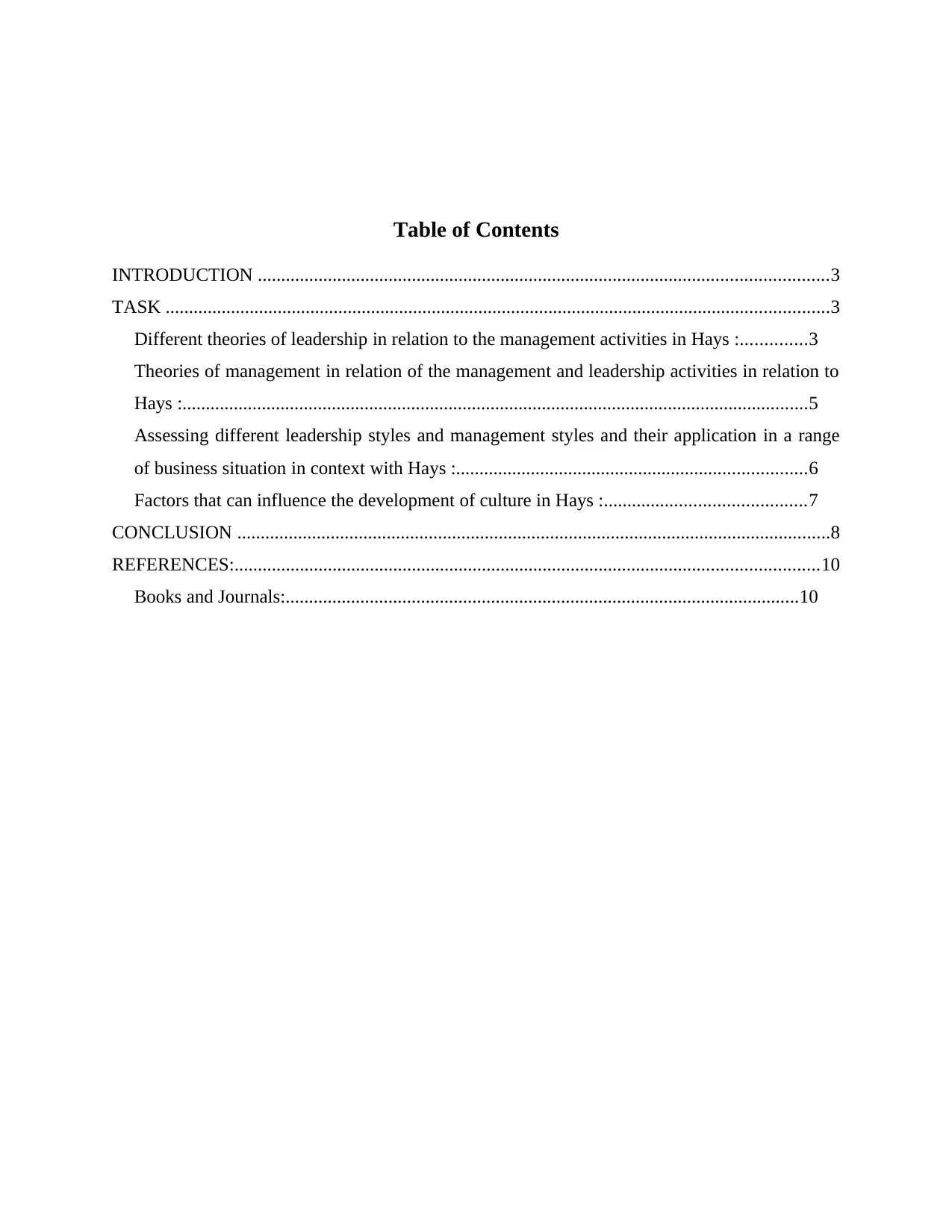
Table of Contents
INTRODUCTION ..........................................................................................................................3
TASK ..............................................................................................................................................3
Different theories of leadership in relation to the management activities in Hays :..............3
Theories of management in relation of the management and leadership activities in relation to
Hays :......................................................................................................................................5
Assessing different leadership styles and management styles and their application in a range
of business situation in context with Hays :...........................................................................6
Factors that can influence the development of culture in Hays :...........................................7
CONCLUSION ...............................................................................................................................8
REFERENCES:.............................................................................................................................10
Books and Journals:..............................................................................................................10
INTRODUCTION ..........................................................................................................................3
TASK ..............................................................................................................................................3
Different theories of leadership in relation to the management activities in Hays :..............3
Theories of management in relation of the management and leadership activities in relation to
Hays :......................................................................................................................................5
Assessing different leadership styles and management styles and their application in a range
of business situation in context with Hays :...........................................................................6
Factors that can influence the development of culture in Hays :...........................................7
CONCLUSION ...............................................................................................................................8
REFERENCES:.............................................................................................................................10
Books and Journals:..............................................................................................................10
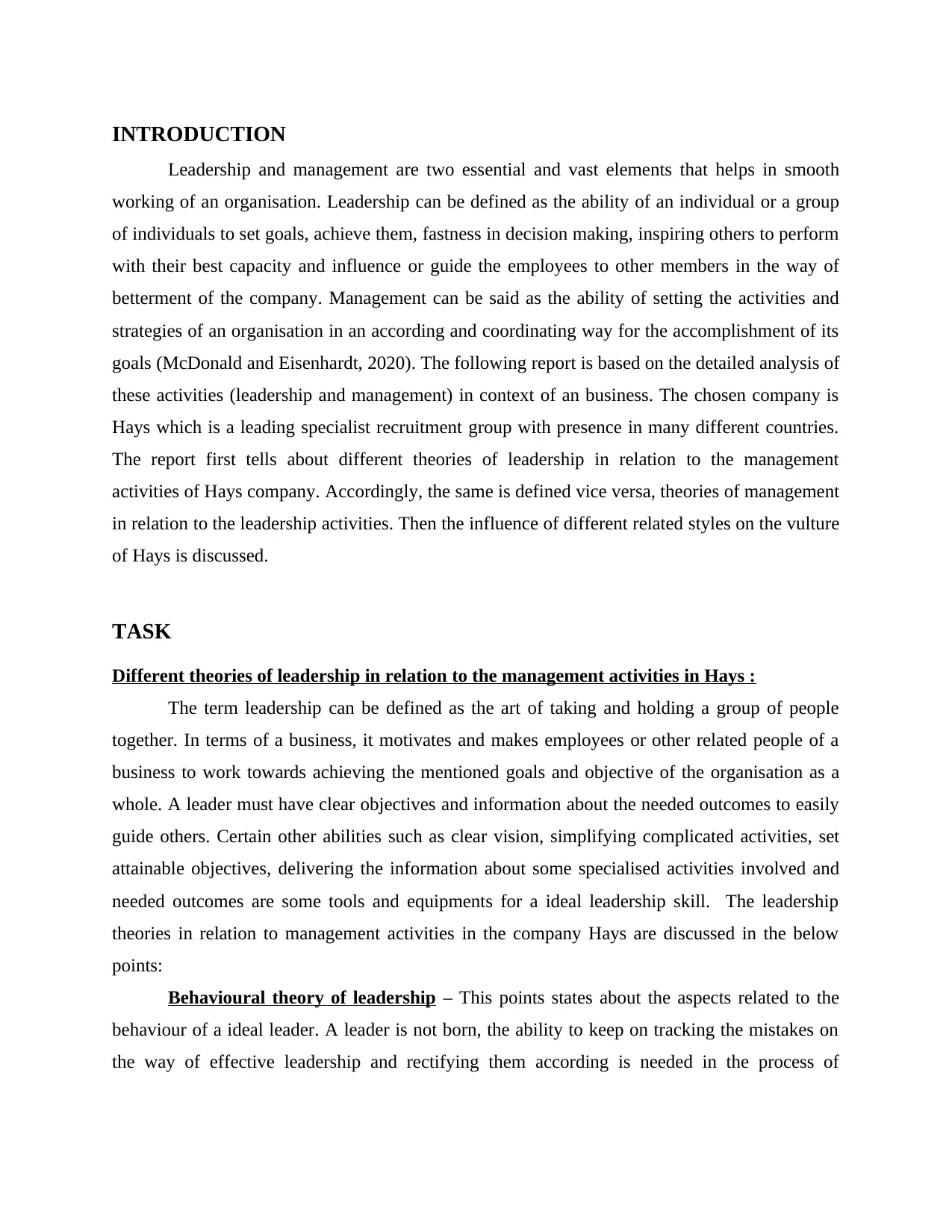
INTRODUCTION
Leadership and management are two essential and vast elements that helps in smooth
working of an organisation. Leadership can be defined as the ability of an individual or a group
of individuals to set goals, achieve them, fastness in decision making, inspiring others to perform
with their best capacity and influence or guide the employees to other members in the way of
betterment of the company. Management can be said as the ability of setting the activities and
strategies of an organisation in an according and coordinating way for the accomplishment of its
goals (McDonald and Eisenhardt, 2020). The following report is based on the detailed analysis of
these activities (leadership and management) in context of an business. The chosen company is
Hays which is a leading specialist recruitment group with presence in many different countries.
The report first tells about different theories of leadership in relation to the management
activities of Hays company. Accordingly, the same is defined vice versa, theories of management
in relation to the leadership activities. Then the influence of different related styles on the vulture
of Hays is discussed.
TASK
Different theories of leadership in relation to the management activities in Hays :
The term leadership can be defined as the art of taking and holding a group of people
together. In terms of a business, it motivates and makes employees or other related people of a
business to work towards achieving the mentioned goals and objective of the organisation as a
whole. A leader must have clear objectives and information about the needed outcomes to easily
guide others. Certain other abilities such as clear vision, simplifying complicated activities, set
attainable objectives, delivering the information about some specialised activities involved and
needed outcomes are some tools and equipments for a ideal leadership skill. The leadership
theories in relation to management activities in the company Hays are discussed in the below
points:
Behavioural theory of leadership – This points states about the aspects related to the
behaviour of a ideal leader. A leader is not born, the ability to keep on tracking the mistakes on
the way of effective leadership and rectifying them according is needed in the process of
Leadership and management are two essential and vast elements that helps in smooth
working of an organisation. Leadership can be defined as the ability of an individual or a group
of individuals to set goals, achieve them, fastness in decision making, inspiring others to perform
with their best capacity and influence or guide the employees to other members in the way of
betterment of the company. Management can be said as the ability of setting the activities and
strategies of an organisation in an according and coordinating way for the accomplishment of its
goals (McDonald and Eisenhardt, 2020). The following report is based on the detailed analysis of
these activities (leadership and management) in context of an business. The chosen company is
Hays which is a leading specialist recruitment group with presence in many different countries.
The report first tells about different theories of leadership in relation to the management
activities of Hays company. Accordingly, the same is defined vice versa, theories of management
in relation to the leadership activities. Then the influence of different related styles on the vulture
of Hays is discussed.
TASK
Different theories of leadership in relation to the management activities in Hays :
The term leadership can be defined as the art of taking and holding a group of people
together. In terms of a business, it motivates and makes employees or other related people of a
business to work towards achieving the mentioned goals and objective of the organisation as a
whole. A leader must have clear objectives and information about the needed outcomes to easily
guide others. Certain other abilities such as clear vision, simplifying complicated activities, set
attainable objectives, delivering the information about some specialised activities involved and
needed outcomes are some tools and equipments for a ideal leadership skill. The leadership
theories in relation to management activities in the company Hays are discussed in the below
points:
Behavioural theory of leadership – This points states about the aspects related to the
behaviour of a ideal leader. A leader is not born, the ability to keep on tracking the mistakes on
the way of effective leadership and rectifying them according is needed in the process of
⊘ This is a preview!⊘
Do you want full access?
Subscribe today to unlock all pages.

Trusted by 1+ million students worldwide
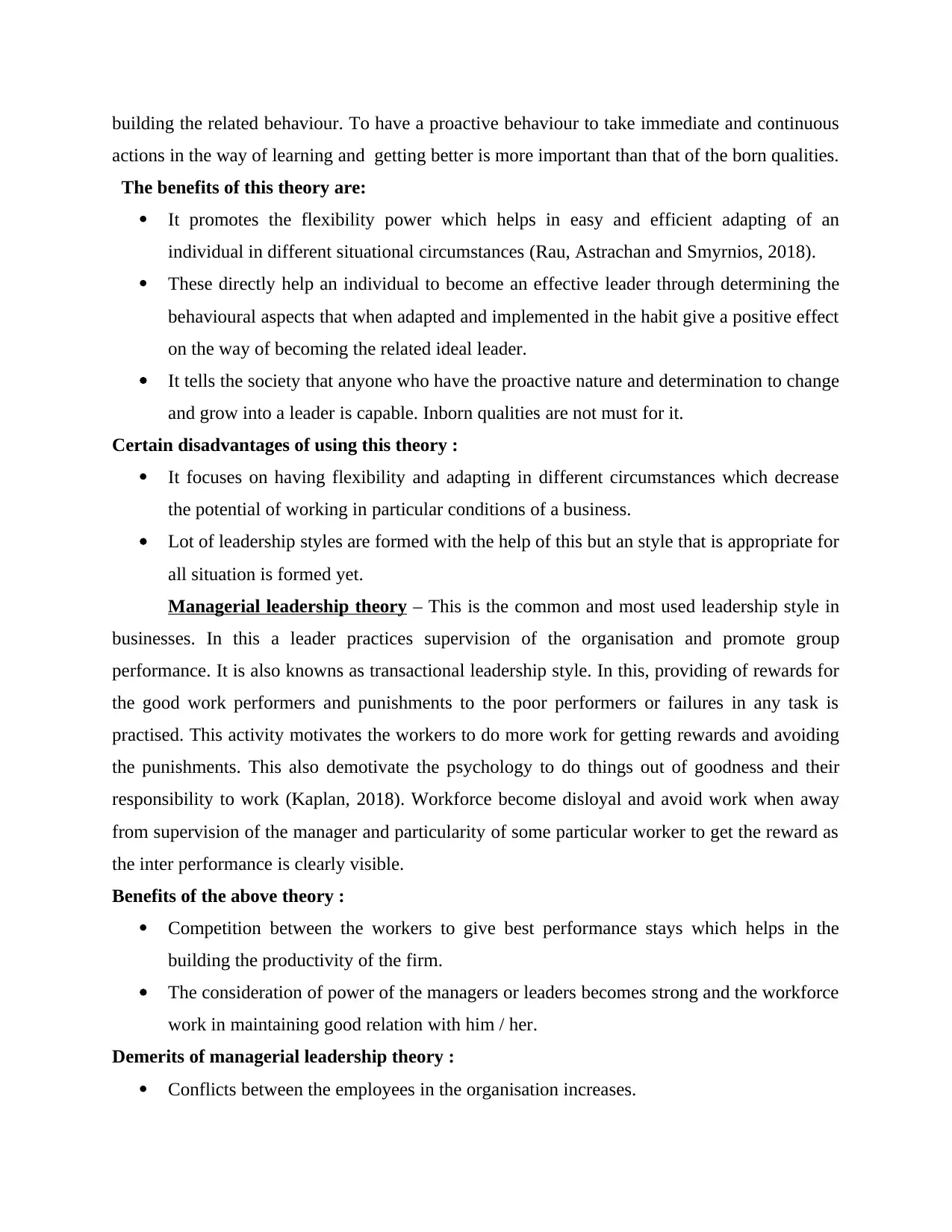
building the related behaviour. To have a proactive behaviour to take immediate and continuous
actions in the way of learning and getting better is more important than that of the born qualities.
The benefits of this theory are:
It promotes the flexibility power which helps in easy and efficient adapting of an
individual in different situational circumstances (Rau, Astrachan and Smyrnios, 2018).
These directly help an individual to become an effective leader through determining the
behavioural aspects that when adapted and implemented in the habit give a positive effect
on the way of becoming the related ideal leader.
It tells the society that anyone who have the proactive nature and determination to change
and grow into a leader is capable. Inborn qualities are not must for it.
Certain disadvantages of using this theory :
It focuses on having flexibility and adapting in different circumstances which decrease
the potential of working in particular conditions of a business.
Lot of leadership styles are formed with the help of this but an style that is appropriate for
all situation is formed yet.
Managerial leadership theory – This is the common and most used leadership style in
businesses. In this a leader practices supervision of the organisation and promote group
performance. It is also knowns as transactional leadership style. In this, providing of rewards for
the good work performers and punishments to the poor performers or failures in any task is
practised. This activity motivates the workers to do more work for getting rewards and avoiding
the punishments. This also demotivate the psychology to do things out of goodness and their
responsibility to work (Kaplan, 2018). Workforce become disloyal and avoid work when away
from supervision of the manager and particularity of some particular worker to get the reward as
the inter performance is clearly visible.
Benefits of the above theory :
Competition between the workers to give best performance stays which helps in the
building the productivity of the firm.
The consideration of power of the managers or leaders becomes strong and the workforce
work in maintaining good relation with him / her.
Demerits of managerial leadership theory :
Conflicts between the employees in the organisation increases.
actions in the way of learning and getting better is more important than that of the born qualities.
The benefits of this theory are:
It promotes the flexibility power which helps in easy and efficient adapting of an
individual in different situational circumstances (Rau, Astrachan and Smyrnios, 2018).
These directly help an individual to become an effective leader through determining the
behavioural aspects that when adapted and implemented in the habit give a positive effect
on the way of becoming the related ideal leader.
It tells the society that anyone who have the proactive nature and determination to change
and grow into a leader is capable. Inborn qualities are not must for it.
Certain disadvantages of using this theory :
It focuses on having flexibility and adapting in different circumstances which decrease
the potential of working in particular conditions of a business.
Lot of leadership styles are formed with the help of this but an style that is appropriate for
all situation is formed yet.
Managerial leadership theory – This is the common and most used leadership style in
businesses. In this a leader practices supervision of the organisation and promote group
performance. It is also knowns as transactional leadership style. In this, providing of rewards for
the good work performers and punishments to the poor performers or failures in any task is
practised. This activity motivates the workers to do more work for getting rewards and avoiding
the punishments. This also demotivate the psychology to do things out of goodness and their
responsibility to work (Kaplan, 2018). Workforce become disloyal and avoid work when away
from supervision of the manager and particularity of some particular worker to get the reward as
the inter performance is clearly visible.
Benefits of the above theory :
Competition between the workers to give best performance stays which helps in the
building the productivity of the firm.
The consideration of power of the managers or leaders becomes strong and the workforce
work in maintaining good relation with him / her.
Demerits of managerial leadership theory :
Conflicts between the employees in the organisation increases.
Paraphrase This Document
Need a fresh take? Get an instant paraphrase of this document with our AI Paraphraser
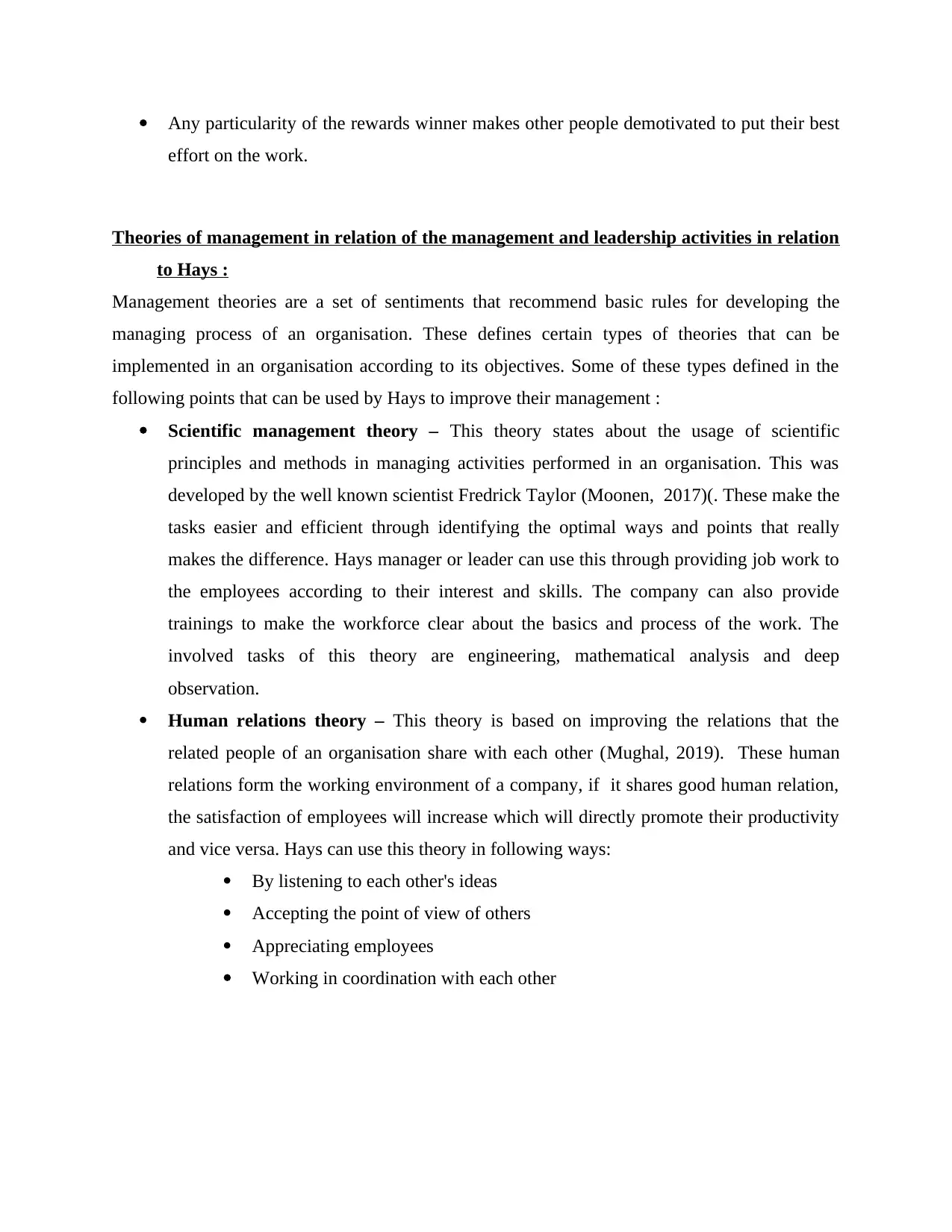
Any particularity of the rewards winner makes other people demotivated to put their best
effort on the work.
Theories of management in relation of the management and leadership activities in relation
to Hays :
Management theories are a set of sentiments that recommend basic rules for developing the
managing process of an organisation. These defines certain types of theories that can be
implemented in an organisation according to its objectives. Some of these types defined in the
following points that can be used by Hays to improve their management :
Scientific management theory – This theory states about the usage of scientific
principles and methods in managing activities performed in an organisation. This was
developed by the well known scientist Fredrick Taylor (Moonen, 2017)(. These make the
tasks easier and efficient through identifying the optimal ways and points that really
makes the difference. Hays manager or leader can use this through providing job work to
the employees according to their interest and skills. The company can also provide
trainings to make the workforce clear about the basics and process of the work. The
involved tasks of this theory are engineering, mathematical analysis and deep
observation.
Human relations theory – This theory is based on improving the relations that the
related people of an organisation share with each other (Mughal, 2019). These human
relations form the working environment of a company, if it shares good human relation,
the satisfaction of employees will increase which will directly promote their productivity
and vice versa. Hays can use this theory in following ways:
By listening to each other's ideas
Accepting the point of view of others
Appreciating employees
Working in coordination with each other
effort on the work.
Theories of management in relation of the management and leadership activities in relation
to Hays :
Management theories are a set of sentiments that recommend basic rules for developing the
managing process of an organisation. These defines certain types of theories that can be
implemented in an organisation according to its objectives. Some of these types defined in the
following points that can be used by Hays to improve their management :
Scientific management theory – This theory states about the usage of scientific
principles and methods in managing activities performed in an organisation. This was
developed by the well known scientist Fredrick Taylor (Moonen, 2017)(. These make the
tasks easier and efficient through identifying the optimal ways and points that really
makes the difference. Hays manager or leader can use this through providing job work to
the employees according to their interest and skills. The company can also provide
trainings to make the workforce clear about the basics and process of the work. The
involved tasks of this theory are engineering, mathematical analysis and deep
observation.
Human relations theory – This theory is based on improving the relations that the
related people of an organisation share with each other (Mughal, 2019). These human
relations form the working environment of a company, if it shares good human relation,
the satisfaction of employees will increase which will directly promote their productivity
and vice versa. Hays can use this theory in following ways:
By listening to each other's ideas
Accepting the point of view of others
Appreciating employees
Working in coordination with each other
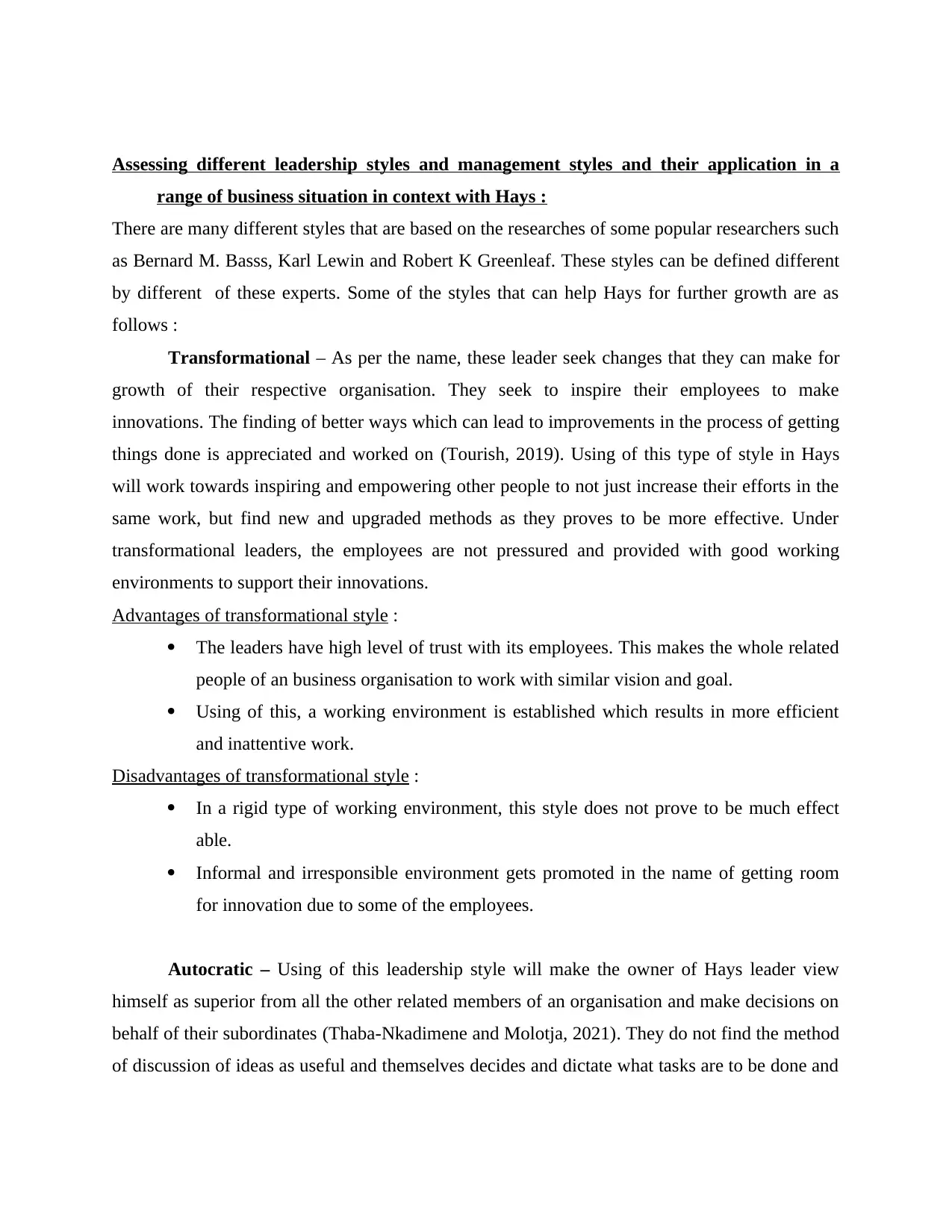
Assessing different leadership styles and management styles and their application in a
range of business situation in context with Hays :
There are many different styles that are based on the researches of some popular researchers such
as Bernard M. Basss, Karl Lewin and Robert K Greenleaf. These styles can be defined different
by different of these experts. Some of the styles that can help Hays for further growth are as
follows :
Transformational – As per the name, these leader seek changes that they can make for
growth of their respective organisation. They seek to inspire their employees to make
innovations. The finding of better ways which can lead to improvements in the process of getting
things done is appreciated and worked on (Tourish, 2019). Using of this type of style in Hays
will work towards inspiring and empowering other people to not just increase their efforts in the
same work, but find new and upgraded methods as they proves to be more effective. Under
transformational leaders, the employees are not pressured and provided with good working
environments to support their innovations.
Advantages of transformational style :
The leaders have high level of trust with its employees. This makes the whole related
people of an business organisation to work with similar vision and goal.
Using of this, a working environment is established which results in more efficient
and inattentive work.
Disadvantages of transformational style :
In a rigid type of working environment, this style does not prove to be much effect
able.
Informal and irresponsible environment gets promoted in the name of getting room
for innovation due to some of the employees.
Autocratic – Using of this leadership style will make the owner of Hays leader view
himself as superior from all the other related members of an organisation and make decisions on
behalf of their subordinates (Thaba-Nkadimene and Molotja, 2021). They do not find the method
of discussion of ideas as useful and themselves decides and dictate what tasks are to be done and
range of business situation in context with Hays :
There are many different styles that are based on the researches of some popular researchers such
as Bernard M. Basss, Karl Lewin and Robert K Greenleaf. These styles can be defined different
by different of these experts. Some of the styles that can help Hays for further growth are as
follows :
Transformational – As per the name, these leader seek changes that they can make for
growth of their respective organisation. They seek to inspire their employees to make
innovations. The finding of better ways which can lead to improvements in the process of getting
things done is appreciated and worked on (Tourish, 2019). Using of this type of style in Hays
will work towards inspiring and empowering other people to not just increase their efforts in the
same work, but find new and upgraded methods as they proves to be more effective. Under
transformational leaders, the employees are not pressured and provided with good working
environments to support their innovations.
Advantages of transformational style :
The leaders have high level of trust with its employees. This makes the whole related
people of an business organisation to work with similar vision and goal.
Using of this, a working environment is established which results in more efficient
and inattentive work.
Disadvantages of transformational style :
In a rigid type of working environment, this style does not prove to be much effect
able.
Informal and irresponsible environment gets promoted in the name of getting room
for innovation due to some of the employees.
Autocratic – Using of this leadership style will make the owner of Hays leader view
himself as superior from all the other related members of an organisation and make decisions on
behalf of their subordinates (Thaba-Nkadimene and Molotja, 2021). They do not find the method
of discussion of ideas as useful and themselves decides and dictate what tasks are to be done and
⊘ This is a preview!⊘
Do you want full access?
Subscribe today to unlock all pages.

Trusted by 1+ million students worldwide
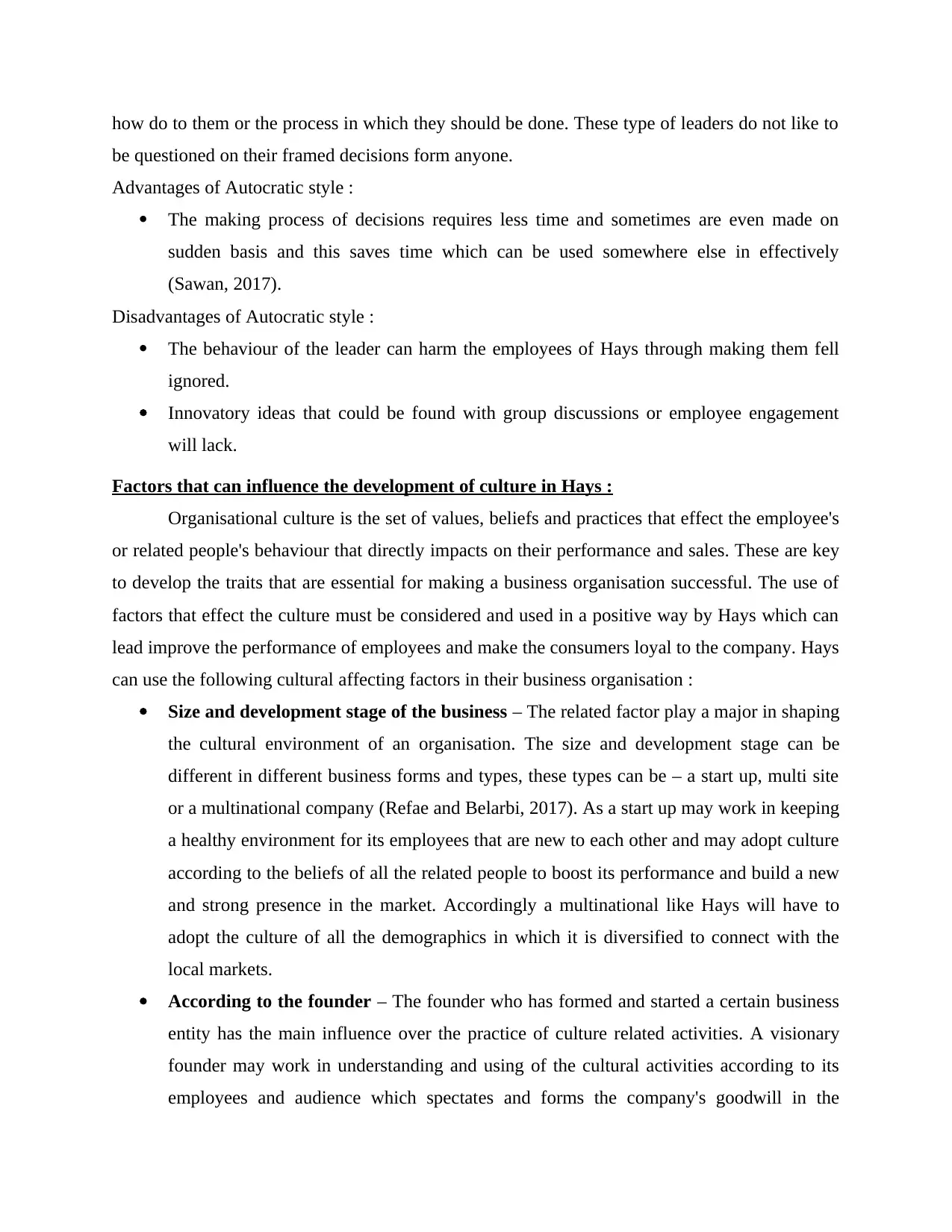
how do to them or the process in which they should be done. These type of leaders do not like to
be questioned on their framed decisions form anyone.
Advantages of Autocratic style :
The making process of decisions requires less time and sometimes are even made on
sudden basis and this saves time which can be used somewhere else in effectively
(Sawan, 2017).
Disadvantages of Autocratic style :
The behaviour of the leader can harm the employees of Hays through making them fell
ignored.
Innovatory ideas that could be found with group discussions or employee engagement
will lack.
Factors that can influence the development of culture in Hays :
Organisational culture is the set of values, beliefs and practices that effect the employee's
or related people's behaviour that directly impacts on their performance and sales. These are key
to develop the traits that are essential for making a business organisation successful. The use of
factors that effect the culture must be considered and used in a positive way by Hays which can
lead improve the performance of employees and make the consumers loyal to the company. Hays
can use the following cultural affecting factors in their business organisation :
Size and development stage of the business – The related factor play a major in shaping
the cultural environment of an organisation. The size and development stage can be
different in different business forms and types, these types can be – a start up, multi site
or a multinational company (Refae and Belarbi, 2017). As a start up may work in keeping
a healthy environment for its employees that are new to each other and may adopt culture
according to the beliefs of all the related people to boost its performance and build a new
and strong presence in the market. Accordingly a multinational like Hays will have to
adopt the culture of all the demographics in which it is diversified to connect with the
local markets.
According to the founder – The founder who has formed and started a certain business
entity has the main influence over the practice of culture related activities. A visionary
founder may work in understanding and using of the cultural activities according to its
employees and audience which spectates and forms the company's goodwill in the
be questioned on their framed decisions form anyone.
Advantages of Autocratic style :
The making process of decisions requires less time and sometimes are even made on
sudden basis and this saves time which can be used somewhere else in effectively
(Sawan, 2017).
Disadvantages of Autocratic style :
The behaviour of the leader can harm the employees of Hays through making them fell
ignored.
Innovatory ideas that could be found with group discussions or employee engagement
will lack.
Factors that can influence the development of culture in Hays :
Organisational culture is the set of values, beliefs and practices that effect the employee's
or related people's behaviour that directly impacts on their performance and sales. These are key
to develop the traits that are essential for making a business organisation successful. The use of
factors that effect the culture must be considered and used in a positive way by Hays which can
lead improve the performance of employees and make the consumers loyal to the company. Hays
can use the following cultural affecting factors in their business organisation :
Size and development stage of the business – The related factor play a major in shaping
the cultural environment of an organisation. The size and development stage can be
different in different business forms and types, these types can be – a start up, multi site
or a multinational company (Refae and Belarbi, 2017). As a start up may work in keeping
a healthy environment for its employees that are new to each other and may adopt culture
according to the beliefs of all the related people to boost its performance and build a new
and strong presence in the market. Accordingly a multinational like Hays will have to
adopt the culture of all the demographics in which it is diversified to connect with the
local markets.
According to the founder – The founder who has formed and started a certain business
entity has the main influence over the practice of culture related activities. A visionary
founder may work in understanding and using of the cultural activities according to its
employees and audience which spectates and forms the company's goodwill in the
Paraphrase This Document
Need a fresh take? Get an instant paraphrase of this document with our AI Paraphraser
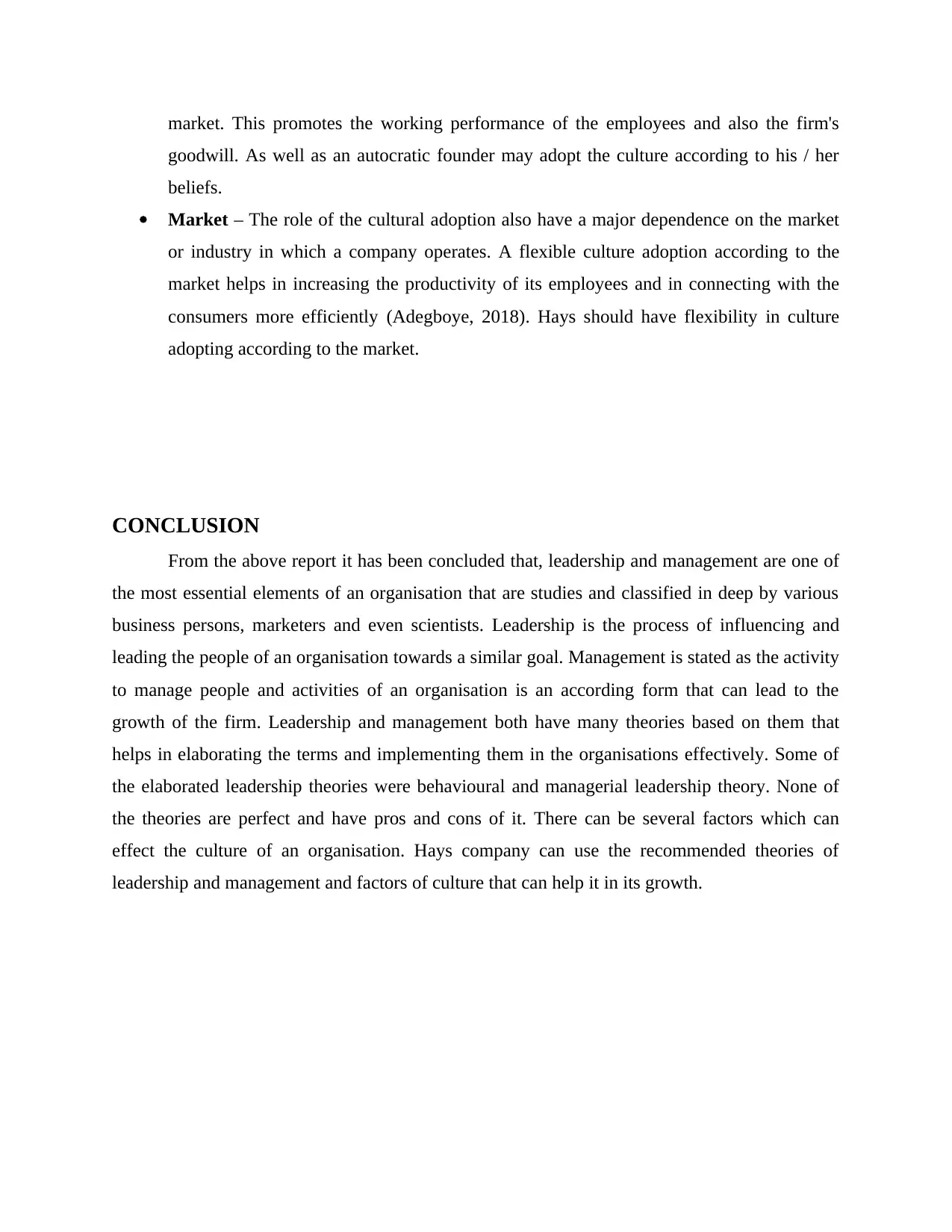
market. This promotes the working performance of the employees and also the firm's
goodwill. As well as an autocratic founder may adopt the culture according to his / her
beliefs.
Market – The role of the cultural adoption also have a major dependence on the market
or industry in which a company operates. A flexible culture adoption according to the
market helps in increasing the productivity of its employees and in connecting with the
consumers more efficiently (Adegboye, 2018). Hays should have flexibility in culture
adopting according to the market.
CONCLUSION
From the above report it has been concluded that, leadership and management are one of
the most essential elements of an organisation that are studies and classified in deep by various
business persons, marketers and even scientists. Leadership is the process of influencing and
leading the people of an organisation towards a similar goal. Management is stated as the activity
to manage people and activities of an organisation is an according form that can lead to the
growth of the firm. Leadership and management both have many theories based on them that
helps in elaborating the terms and implementing them in the organisations effectively. Some of
the elaborated leadership theories were behavioural and managerial leadership theory. None of
the theories are perfect and have pros and cons of it. There can be several factors which can
effect the culture of an organisation. Hays company can use the recommended theories of
leadership and management and factors of culture that can help it in its growth.
goodwill. As well as an autocratic founder may adopt the culture according to his / her
beliefs.
Market – The role of the cultural adoption also have a major dependence on the market
or industry in which a company operates. A flexible culture adoption according to the
market helps in increasing the productivity of its employees and in connecting with the
consumers more efficiently (Adegboye, 2018). Hays should have flexibility in culture
adopting according to the market.
CONCLUSION
From the above report it has been concluded that, leadership and management are one of
the most essential elements of an organisation that are studies and classified in deep by various
business persons, marketers and even scientists. Leadership is the process of influencing and
leading the people of an organisation towards a similar goal. Management is stated as the activity
to manage people and activities of an organisation is an according form that can lead to the
growth of the firm. Leadership and management both have many theories based on them that
helps in elaborating the terms and implementing them in the organisations effectively. Some of
the elaborated leadership theories were behavioural and managerial leadership theory. None of
the theories are perfect and have pros and cons of it. There can be several factors which can
effect the culture of an organisation. Hays company can use the recommended theories of
leadership and management and factors of culture that can help it in its growth.
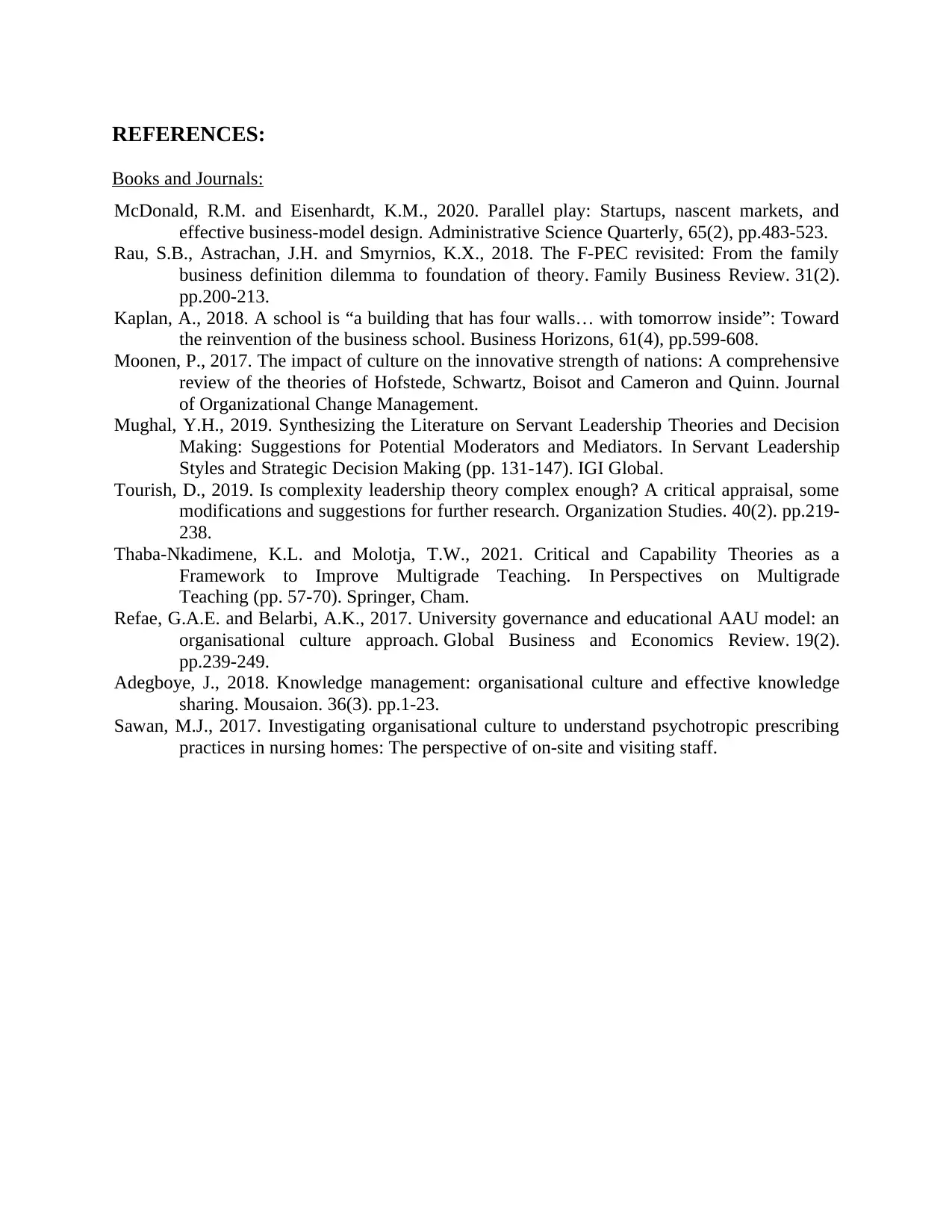
REFERENCES:
Books and Journals:
McDonald, R.M. and Eisenhardt, K.M., 2020. Parallel play: Startups, nascent markets, and
effective business-model design. Administrative Science Quarterly, 65(2), pp.483-523.
Rau, S.B., Astrachan, J.H. and Smyrnios, K.X., 2018. The F-PEC revisited: From the family
business definition dilemma to foundation of theory. Family Business Review. 31(2).
pp.200-213.
Kaplan, A., 2018. A school is “a building that has four walls… with tomorrow inside”: Toward
the reinvention of the business school. Business Horizons, 61(4), pp.599-608.
Moonen, P., 2017. The impact of culture on the innovative strength of nations: A comprehensive
review of the theories of Hofstede, Schwartz, Boisot and Cameron and Quinn. Journal
of Organizational Change Management.
Mughal, Y.H., 2019. Synthesizing the Literature on Servant Leadership Theories and Decision
Making: Suggestions for Potential Moderators and Mediators. In Servant Leadership
Styles and Strategic Decision Making (pp. 131-147). IGI Global.
Tourish, D., 2019. Is complexity leadership theory complex enough? A critical appraisal, some
modifications and suggestions for further research. Organization Studies. 40(2). pp.219-
238.
Thaba-Nkadimene, K.L. and Molotja, T.W., 2021. Critical and Capability Theories as a
Framework to Improve Multigrade Teaching. In Perspectives on Multigrade
Teaching (pp. 57-70). Springer, Cham.
Refae, G.A.E. and Belarbi, A.K., 2017. University governance and educational AAU model: an
organisational culture approach. Global Business and Economics Review. 19(2).
pp.239-249.
Adegboye, J., 2018. Knowledge management: organisational culture and effective knowledge
sharing. Mousaion. 36(3). pp.1-23.
Sawan, M.J., 2017. Investigating organisational culture to understand psychotropic prescribing
practices in nursing homes: The perspective of on-site and visiting staff.
Books and Journals:
McDonald, R.M. and Eisenhardt, K.M., 2020. Parallel play: Startups, nascent markets, and
effective business-model design. Administrative Science Quarterly, 65(2), pp.483-523.
Rau, S.B., Astrachan, J.H. and Smyrnios, K.X., 2018. The F-PEC revisited: From the family
business definition dilemma to foundation of theory. Family Business Review. 31(2).
pp.200-213.
Kaplan, A., 2018. A school is “a building that has four walls… with tomorrow inside”: Toward
the reinvention of the business school. Business Horizons, 61(4), pp.599-608.
Moonen, P., 2017. The impact of culture on the innovative strength of nations: A comprehensive
review of the theories of Hofstede, Schwartz, Boisot and Cameron and Quinn. Journal
of Organizational Change Management.
Mughal, Y.H., 2019. Synthesizing the Literature on Servant Leadership Theories and Decision
Making: Suggestions for Potential Moderators and Mediators. In Servant Leadership
Styles and Strategic Decision Making (pp. 131-147). IGI Global.
Tourish, D., 2019. Is complexity leadership theory complex enough? A critical appraisal, some
modifications and suggestions for further research. Organization Studies. 40(2). pp.219-
238.
Thaba-Nkadimene, K.L. and Molotja, T.W., 2021. Critical and Capability Theories as a
Framework to Improve Multigrade Teaching. In Perspectives on Multigrade
Teaching (pp. 57-70). Springer, Cham.
Refae, G.A.E. and Belarbi, A.K., 2017. University governance and educational AAU model: an
organisational culture approach. Global Business and Economics Review. 19(2).
pp.239-249.
Adegboye, J., 2018. Knowledge management: organisational culture and effective knowledge
sharing. Mousaion. 36(3). pp.1-23.
Sawan, M.J., 2017. Investigating organisational culture to understand psychotropic prescribing
practices in nursing homes: The perspective of on-site and visiting staff.
⊘ This is a preview!⊘
Do you want full access?
Subscribe today to unlock all pages.

Trusted by 1+ million students worldwide
1 out of 9
Related Documents
Your All-in-One AI-Powered Toolkit for Academic Success.
+13062052269
info@desklib.com
Available 24*7 on WhatsApp / Email
![[object Object]](/_next/static/media/star-bottom.7253800d.svg)
Unlock your academic potential
Copyright © 2020–2025 A2Z Services. All Rights Reserved. Developed and managed by ZUCOL.




